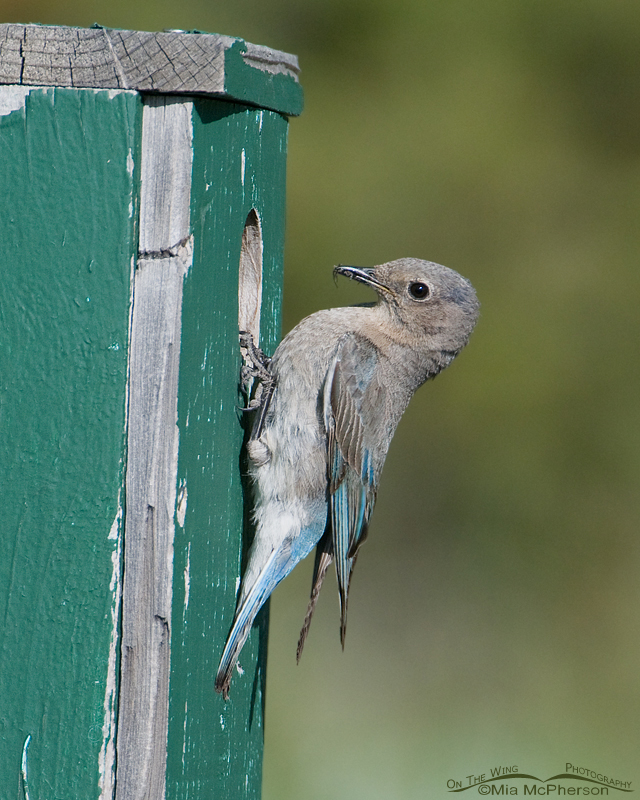 Female Mountain Bluebird with prey at the nest box – Red Rock Lakes National Wildlife Refuge, Montana
Female Mountain Bluebird with prey at the nest box – Red Rock Lakes National Wildlife Refuge, Montana
I found out about Al Larson; aka The Bluebird Man, through Neil Paprocki who is a Raptor Biology Master’s student at Boise State University and the Scientific Director for Wild Lens Inc., a 501(c)3 non-profit video production company focused on addressing wildlife conservation issues. At this time Wild Lens Inc. is producing a half-hour video about Al Larson, his amazing devotion to his Bluebird Trail in Idaho and his role in the recovery of North America’s bluebirds. For 35 years Al Larson has monitored bluebird nest boxes and banded over 27,000 bluebirds.
I live in a city and don’t have bluebird boxes close to home but as a bird photographer I do travel to areas where bluebirds and nest boxes are abundant. I love catching sight of Mountain Bluebirds in flight, those brilliant flashes of blue always catch my eyes. I can’t imagine this country without them and I am grateful for the people who place nest boxes, maintain them and collect valuable information about the bluebirds through observation and banding.
I recently interviewed Neil about bluebirds, cavity nesters and about Al Larson; my favorite Bluebird Man, and wanted to share the interview with you all because I know that all of you are interested in birds, nature and conservation.
Mia: Neil, because of my bird photography I’m aware that Bluebirds, American Kestrels, some swallows and wrens are secondary cavity nesting birds, how many species are there that are secondary cavity nesters?
Neil: There are roughly 80 species of cavity nesting birds of North America. Of these only a handful, namely the woodpeckers, are actually capable of excavating their own nesting cavities. The majority relies on other animals to create their nesting cavities for them: these are the secondary cavity nesters.
Mia: In the 1970’s bluebird populations were at an all time low in North America, those declines were in part caused by habitat destruction, pesticide use, dead tree removal, cats and the introduction of two extremely aggressive cavity nesting species, the European Starlings and House Sparrows. What role did nest boxes have in the reversal of bluebird declines in the 1970’s?
Neil: Nest boxes helped to reverse population declines on a number of fronts. The first is that they helped restore the number of nesting cavities available to bluebirds that had been taken away by the removal of dead trees. The second is that by carefully constructing nest boxes people were able to reduce the amount of competition from introduced species.
European Starlings are larger birds so by decreasing the size of the nest box opening people were able to prevent them from entering nest boxes. House Sparrows are a different sort of situation and still cause problems for bluebirds even today. House Sparrows are very aggressive birds and will out-compete bluebirds for cavities at every opportunity. You can read more about House Sparrow control at the North American Bluebird Society website.
Mia: If people want to become involved with their local bluebird trails or other nest box programs how could they go about locating those organizations?
Neil: You can get involved in bluebird preservation projects by contacting your local Audubon or Bluebird Society chapter. You can visit the Audubon Society and North American Bluebird Society websites for your local affiliates contact information. Go and check out another person’s bluebird project before deciding if this is something you really want to do. But I will warn you, it is very easy to get hooked and addicted to watching bluebirds!
Mia: I normally notice bluebird nest boxes along country roads, fence posts in rural settings, green spaces and in parks but I rarely notice them in the backyards of people who live in cities, why is that? What locations or habitats are optimal for bluebird nest box placement?
Neil: Bluebirds prefer their nesting cavities near open areas because they readily forage for insects along the ground. Optimal habitats for bluebird nest box placement are locations near open fields, parks, or other habitats devoid of dense tree cover.
The reason you don’t see many bluebird boxes in cities is because there is a general lack of open space. By placing a bluebird box in an urban setting lacking open space you may be inviting in House Sparrows. There are other options for us urban dwellers however. Many put up nest boxes with smaller openings for Chickadees and House Wrens that keep House Sparrows out but provide great nesting habitat for other native cavity nesters.
Mia: As a bird photographer I realize that nest boxes can offer me opportunities to photograph, observe and study secondary cavity nesters which provides me with a great way to connect to these birds, do they also contribute ways for other people to connect with them?
Neil: It is funny that you mention this Mia, because that is precisely why the subject of our film Al Larson began putting up nest boxes in the late 1970s: as a way to conveniently photograph bluebirds! That was just the gateway to a 35-year connection he has developed with these birds though.
Nest boxes are great because it gives you a location where you know birds are going to nest. This allows you the unique opportunity to introduce birds and bird conservation to people who have never seen a bird up close, or never taken the time to notice them. Having witnessed this first hand, it is amazing how captivated people are to see birds so close, especially baby birds in a nest box!
When people can see that connection for themselves, it ends up being something that sticks with them for a long time.
Mia: Could you tell me what you think we can learn from Al Larson’s life story and 35 year commitment to bluebirds? He seems like such a fascinating man and his devotion to the bluebirds is highly admirable.
Neil: Many people think you need to be a scientist with an advanced degree to study birds. Well this is simply not the case and Al is a perfect example of this.
While Al ended up getting his GED later in life, his formal education ended after the 8th grade. Nevertheless, he knows more about the intimate habits of bluebirds than anyone I have ever met. He is a hardworking ‘everyman’, and just goes to show anyone can pursue the things they love.
He wanted to study and help out the bluebirds, so he just did it. He took great care while doing so, and did his do-diligence to research how to take care of nest boxes, but anyone willing to put in the work and commitment could do what Al has done. He is truly an inspiration.
Mia: I am a huge supporter of controlling pests naturally, does providing nest boxes for secondary cavity nesters help with natural pest control near the boxes?
Neil: While I don’t think anyone has come up with a solution to the problem of introduced pests such as European Starlings and House Sparrows, I do think having bluebird boxes around your property can at least help control insect pests.
Bluebirds are insectivores and I have personally seen them bring every type of insect you can think of back to the nest. In one morning at a particular box, I saw ma and pa bluebird bring back more than 10 cicadas to their nestlings. That seems like a great natural pest control to me.
I have no direct evidence for this, but I would imagine having a bluebird box around your garden at home could be a great thing as well. Bluebirds forage for insects on the ground and I bet they would go to town on a lot of those that infest our vegetable gardens every year.
Mia: Other than their obvious beauty why are bluebirds so charismatic? What about all the other cavity nesters?
Neil: Certainly the beauty of bluebirds is a huge reason behind why they are so charismatic. I think another reason is because North America is the only continent on earth that has bluebirds. There are only three species of bluebird and they are found only in our backyards, pretty neat!
That being said, each and every cavity nester is special and unique in it’s own way. From the massive and triumphant Pileated Woodpeckers to the cute and tiny Pygmy Nuthatch, nest boxes can help provide many cavity nesters with additional nesting habitat.
Mia: It seems to me that monitoring and maintaining nest boxes after they are put up would be important, can you explain why?
Neil: This is extremely important for a variety of reasons, and is probably just as, if not more important than actually putting up the nest box itself. The main reason we need to maintain our nest boxes is to help keep predators and introduced species out. One of the best ways to keep House Sparrows out of nest boxes is to clean out their nests before they get established.
Another reason nest box maintenance is crucial is because birds actually build nests within the boxes. If boxes were not cleaned out after each breeding season, they would soon fill up with nesting material, making them unusable for future generations. In order to keep this nesting habitat available to the birds we have to take care of them.
Mia: After Mr. Larson is unable to maintain his bluebird trail, what are the next steps to ensuring that his (and all the other bluebird trail maintainers) legacy of environmental stewardship is continued?
Neil: This is precisely what I am trying to accomplish with our new film Bluebird Man. In order to ensure that this fantastic conservation success story continues, we must inspire the next generation of ‘bluebirders’. Our film will help educate those people who don’t know much about birds but might be able to connect with Al’s story.
Bluebird Man will also help inspire bird enthusiasts to do something more. Humans have already shaped the world in ways we never imagined, and we are all now responsible for preserving it’s future for years to come. What legacy do we want to leave for our children or grandchildren? I hope this film can play a tiny role in leaving behind a positive legacy of environmental stewardship for the next generation.
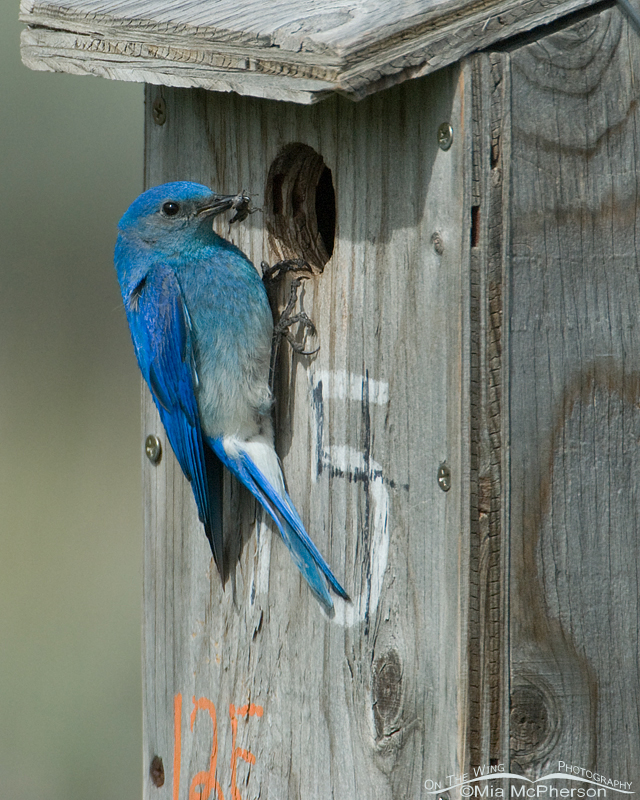 Male Mountain Bluebird with prey at nest box – Red Rock Lakes National Wildlife Refuge, Montana
Male Mountain Bluebird with prey at nest box – Red Rock Lakes National Wildlife Refuge, Montana
Neil and I had a wonderful phone conversation about bluebirds and where we have seen them, my images on this post were all taken at Red Rock Lakes National Wildlife Refuge in southwestern Montana, a location many of you who read my blog know as one of my favorite locations.
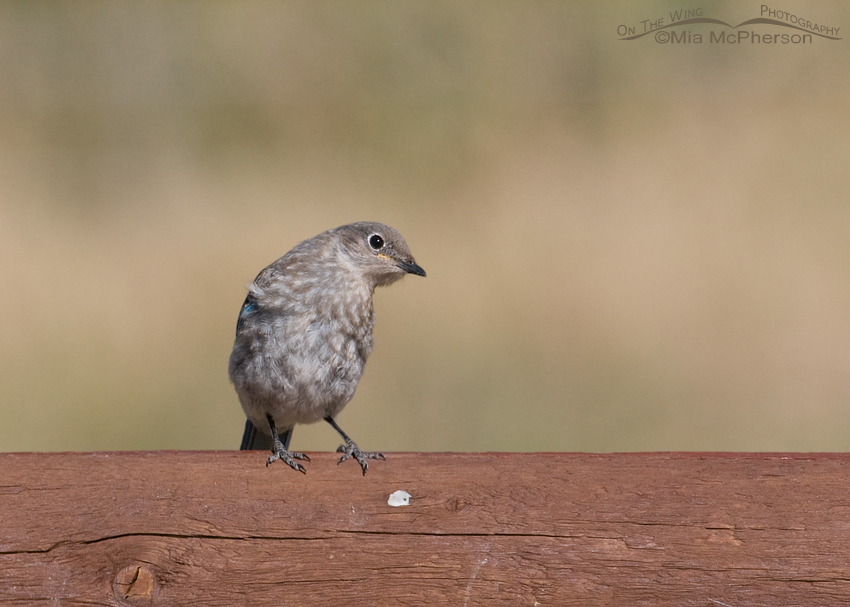 Juvenile Mountain Bluebird on a fence – Red Rock Lakes National Wildlife Refuge, Montana
Juvenile Mountain Bluebird on a fence – Red Rock Lakes National Wildlife Refuge, Montana
Neil spent last weekend in the Eagle Cap Wilderness of eastern Oregon where he found two natural nest cavities occupied by Mountain Bluebirds.
There is a short clip with Al Larson talking about his Bluebird Trail on this page that I hope you will watch because you’ll get to “meet” the Bluebird Man. Personally I can’t wait to see the final movie!
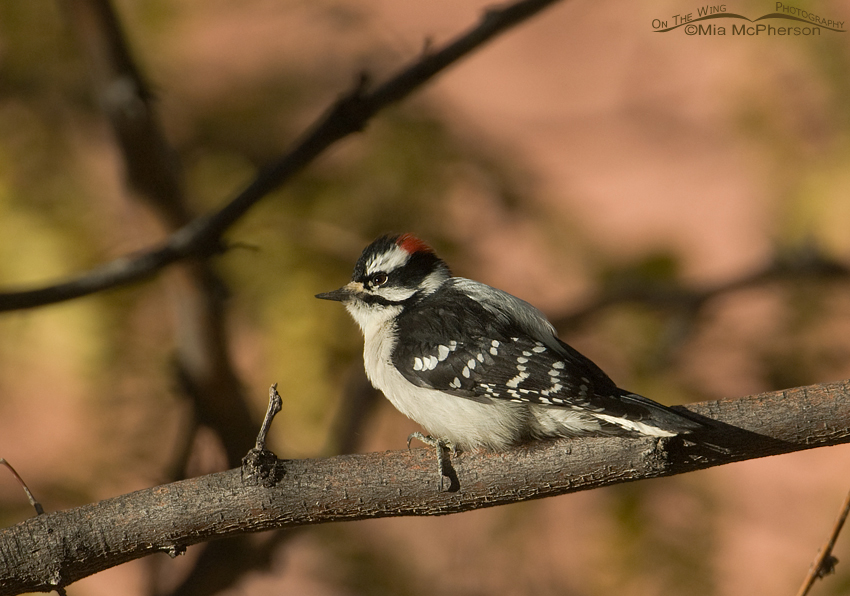 Male Downy Woodpecker – A primary cavity nester – Capitol Reef National Park, Utah
Male Downy Woodpecker – A primary cavity nester – Capitol Reef National Park, Utah
There simply aren’t enough natural cavities for secondary cavity nesting birds and nest boxes; though man-made, have helped secondary cavity nesting birds make a come back and that is thanks to Al Larson and other people and organizations who create, maintain and monitor Bluebird Trails. I know that when I lived in the country I would leave dead trees standing in my yard if they weren’t a safety concern because I hoped the Pileated, Downy and Hairy Woodpeckers would create natural cavities where I could observe them and hoped that later some Eastern Bluebirds would nest in them too. I did have a few pairs of Eastern Bluebirds raise young in the nest boxes I provided.
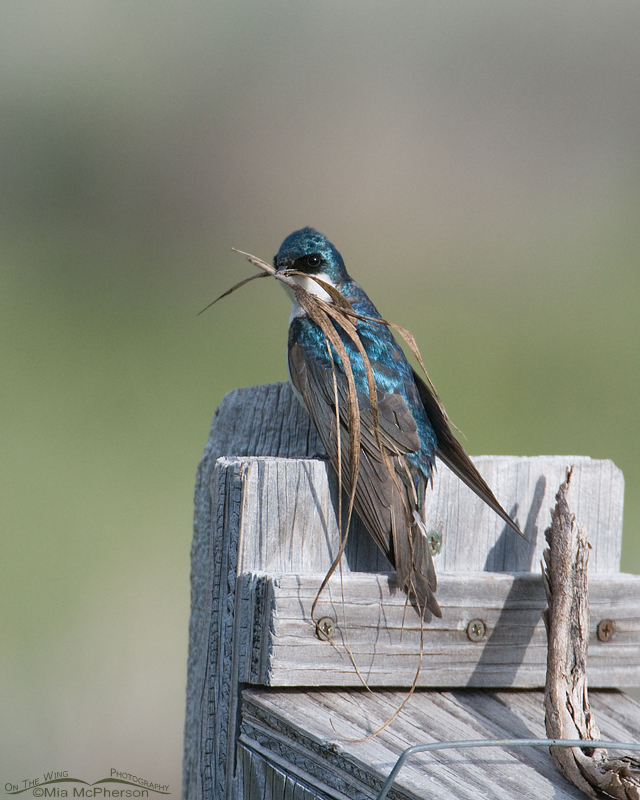 Male Tree Swallow with nesting material – A secondary cavity nester – Red Rock Lakes National Wildlife Refuge, Montana
Male Tree Swallow with nesting material – A secondary cavity nester – Red Rock Lakes National Wildlife Refuge, Montana
I want to thank Neil Paprocki for sharing information about Al Larson and the upcoming film The Bluebird Man, I have learned a lot from the web site and through my interview with Neil and I am all for learning more about the wonderful natural world around me.
Al Larson’s story and his legacy should be shared now and with future generations.
Life is good.
Mia
Click here to see more of my bird photos in their galleries.


Thank you all for your comments on this important post about cavity nesters, Al Larson and the upcoming movie “The Bluebird Man”.
Wonderful! Pretty exciting stuff today on bluebirds. I hadn’t a clue about the cavity nesters. I need to start doing this.
What a wonderful story, thanks so much for sharing, Mia!
Fantastic, Mia! Although I loved the entire interview, I think my favorite part is that anyone can indulge their inner conservationist. Selfishly speaking, this appeals to the citizen scientist living inside my liberal arts bones. I appreciating knowing how others, not necessarily trained in biological sciences, come to their passion and commitment on wildlife issues. I’ll be making a contribution at the Kickstarter page. Thanks for letting us know about this project.
I appreciating knowing how others, not necessarily trained in biological sciences, come to their passion and commitment on wildlife issues. I’ll be making a contribution at the Kickstarter page. Thanks for letting us know about this project.
very nice serie mia, this blue bird is so beautifull, wow !
thanks mia
have a nice day too =)
My friend, Tom Meyer, puts a section of pipe a little wider than the mounting post just under the box itself when he mounts a nesting box. This way, if a snake, a common predator, tries to reach the box, it gets diverted into the pipe and is unable to reach the box, eggs or babies. This is much like the baffles used to keep squirrels out of pole type feeders. It also helps prevent raccoons from reaching the nest. Boxes fastened against tree trunks, buildings or on top of posts without baffles, don’t do so well
One of my favorite Bluebird pictures is that of the Bluebird sitting in a tidal lagoon photographing a tricolored heron.
LOLOL, I think I know that bird!
I have emailed Neil asking him to chime in on your questions Patty, he might be away from his computer because it is the weekend but I am sure he’ll respond.
I ‘be been told that it helps to put up TWO Bluebird houses… about 10’ apart. This way one may be taken by tree swallows or sparrows who will then chase away others of their own kind, leaving the second free for bluebirds. What do you know about this theory? I’ve noticed that bluebird houses are installed this way along the New York through way.
I had two nest boxes in my yard back east and often one would have the bluebirds in it and the other would have a wren, a toad or my Southern Flying Squirrels. Once I went to open the box towards the fall to remove old nesting materials and there was a black snake in the box! I about fell off of the ladder.
The shock of seeing a black snake when not expecting it would have had the same effect on me.
Patty: Placing two bluebird boxes near each other is a great way to have bluebirds and swallows live together. This does not however, necessarily control for House Sparrows as they can be so aggressive that they may still chase bluebirds away, or another pair of Sparrows will take up residence in the other box. Hope this helps!
Mia, how, when, where can I see this film?
Patty, Neil said they hope to have it available for viewing in December of this year.
As for the film release date, Patty. We are hoping to complete the film by the end of December 2013. We have received a letter of support from Idaho Public Television to broadcast the film on PBS stations throughout Idaho, and will be working towards a more regional/national PBS broadcast too if there is interest. We’d love to have as many folks across the country view this film as possible! That being said, sometime in early 2014 is when we expect to have DVDs ready for release if you are not in an area to view it on TV. Let me know if you have any more questions, and thanks for the interest!
What beautiful photos of these flying jewels…ans such an interesting interview. We have our own “Mr. Bluebird”, a retired banker named Beresford Proctor, who designed, made and gave away more then 4,000 Bluebird housed in his lifetime. Many of them were installed and monitored by our other “Mr. Bluebird”, Tom Meyer. I credit our two Mr. Bluebirds with much of the return of the EaStern Bluebirds in our area. These two men made a big difference by their own actions and by inspiring others to become more active in helping these beautiful birds out. The Bluebird is the state bird of New York. We used to see them when I was a kid because they liked the horse hair for their nests. We have several nesting boxes on family property in Maine, installed in a big, open, uncut field.
Lovely photos and terrific interview Mia! I learned a lot reading it. Keep up the great work.
great article /interview and photos too. thanks.
I love this post Mia and your pics. What I don’t like in the sparrow control section is the “in box trapping method” which seems to require a lot of monitoring and the bird can die in there if not caught in time (either a sparrow or bluebird can be caught in the box). This is such a complex situation that only a group of dedicated people and citizens can make a difference. Education is so crucial for everyone alike who have backyards. Every citizen should be IMOHO putting up these boxes. It’s crucial for everyone to get involved, I think. Thanks for the link.
Great point about “in box trapping”. I did not mean that people should attempt to actually “trap” the bird in the box. What I meant was that if you see of notice a House Sparrow building a nest inside a box, you can open the box up and clear the nest out to try and dissuade them from nesting there. Does that make sense? Education is definitely a critical goal of ours in creating this film and we want people who decide to take the initiative to start a bluebird trail to do so in the most responsible and safe way for the birds.
Thanks Neil, it makes sense. I am, however, totally against what Sialis.org is all about. I don’t see how the attempt of “controlling'” sparrows by euthanasia or clipping wings is even considered. IMOHO I think it’s best to use passive methods. If I have to take a sparrow out of a nesting box; I can deal with that, maybe. But Sialis.org simply does not make any sense. The Passer domesticus is here to stay, and they, for better or worse, do outnumber the Bluebirds. It is useless, IMOHO, to even attempt to “control” them, other than by using the passive and strategic methods mentioned with the boxes.
Maria, I concur with you about your misgivings about the Sialis recommendations. Are the Sialis suggestions ones used widely? Having volunteered in a wildlife hospital where humane euthanasia was strictly monitored, for both native or non-native species, the suggestions for euthanizing House Sparrows make my skin crawl. The ineptitude that occurs when people take these matters into their own hands accounts for so much suffering, irrespective of how one feels about a particular species. That methods like dry ice are listed as possibly or possibly not humane, planting even that seed of an idea, is simply not justified in my view.
The lady that runs Sialis.org is a person who has taken it upon herself to capture large group of Sparrows by luring them into a cage with what she calls “live” decoys. She cuts other sparrows wing’s and puts 2 or 3 of them inside a large cage to lure larger amounts of sparrows to enter the cage and trap them all. She then, either trims all the Sparrow’s wings, or euthanises them. She also does this job for people who have personal backyards in which only Bluebirds are allowed to nest. She’s called in to do this as a “service” to personal friends. She has no background in medicine or wildlife rehab. She runs this website with advice that stems from her own experiments with cages and many deaths from either Bluebirds or Sparrows. She tries to shock the viewer with pictures of dead Bluebirds as results of angry Sparrows. IMOHO this should be made public. This lady proves that her love for Bluebirds is “fanatical” and obsessive. Getting rid of large groups of House Sparrows will not solve any long term problems. This lady is angry and confusing the public with her experiments.
Beautiful images and the discourse between you and Neil.
A great post Mia! Thanks for sharing your interview.
Thanks for sharing this interview, Mia! I love your bluebird photos, they are beautiful birds. Happy weekend!
Thank you Mia and Neil for the interview !
What an inspirational man! Great post Mia and I thoroughly enjoyed the links too. I spent today feeding Helmeted Honeyeaters, a species that only survives because of the amazing people who have dedicated years to helping them. I hope the bluebirds find another generation of Bluebird Men and Women, I’m sure they will.